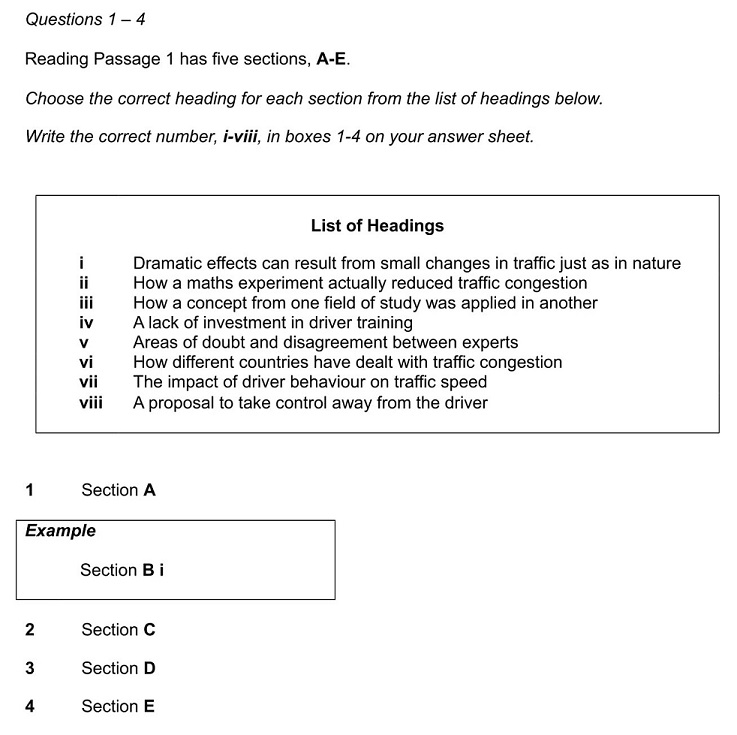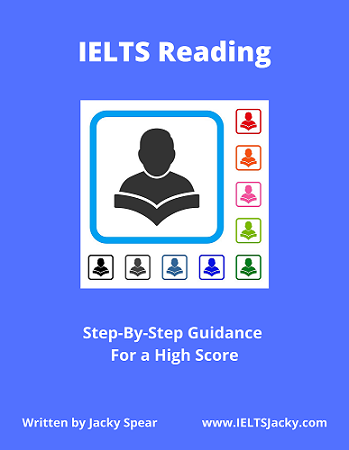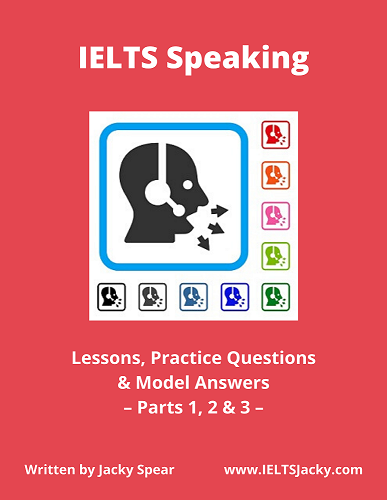IELTS Reading Samples
How To Answer
Matching Headings & Diagram Labelling Questions
These IELTS Reading samples come from real
test papers and I’m going to show you how to answer the questions step-by-step.
Both question types appear regularly in the reading test, so you need to be well prepared in case they come up on your paper.
I’ve written a full page on each of them where you’ll find lots more information and tips, including additional IELTS reading samples explained in detail. Click the links to visit these pages:
Matching Headings & Diagram Labelling
They include:
- Explanations
of the question types
- Skills needed
- Key tips
- Strategies to answer them
- Examples & model answers
IELTS Reading Samples – 1. Matching Headings
Here are a few key things that you need to know before we start work on the text.
a) The aim of Matching
Headings questions is to test if you
are able to understand the main idea of each paragraph.
b) You will be given a text with several sections labelled, for example, A-E, and a list of possible headings to match these sections. Your task is the match them up. However, there will be more headings than there are sections so you won’t need them all.
Also, several headings may be similar in meaning so you'll need to make sure that you fully understand them.
c) Always expect there to be extensive paraphrasing and use of synonyms in this type of question.
d) There are two possible strategies for answering Matching Headings questions:
1) Read text first, then headings.
2) Read headings first, then text.
Some teachers will tell you to always read
the text before you look at the headings while others say you should definitely
read the headings first. Personally, I think the first strategy is the easiest
and it’s the one I’ll be showing you on this page. I do, however, explain both
strategies on the main Matching Headings
page.
So, here are the questions and text of the first of our IELTS reading samples. If you want to use it as a practice test, have a go at answering it yourself before reading my instructions.
I’ve added a PDF of the questions and text that you can download to make it easier to work on. The answers are at the bottom of this page.
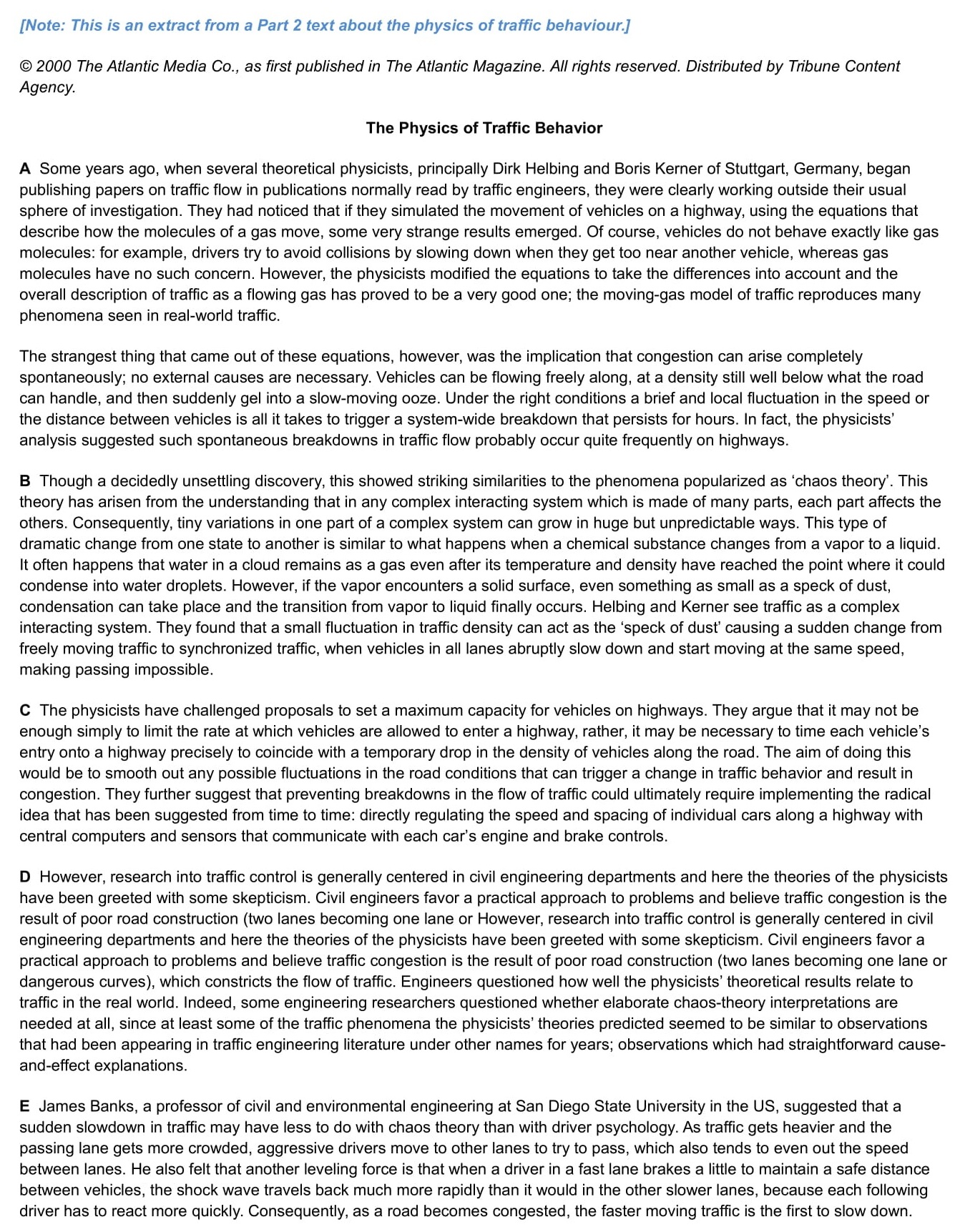
Download PDF of IELTS Reading sample.
Step-By-Step Instructions
1) Read the instructions carefully to make sure that you know what
type of question it is and what you have to do.
In the middle of the instructions are the headings but remember, for this strategy don’t read them yet.
There will sometimes be a sample answer for illustration. In this case, it’s the answer to Section B. Knowing this answer means that you can immediately cross out ‘heading i’ in the list of headings and eliminate it from further consideration.
2) Read the first paragraph.
Your aim is to identify the main idea. Focus on the first one or two sentences and the last sentence as these will probably introduce and summarise this main idea. Skim read the rest of the text. You do not need to know the detail for this type of question.
Note that occasionally a section will contain more than one paragraph. In this case, you’ll need to find the main idea in each paragraph.
3) Summarise the main idea.
Briefly sum up the main idea of the paragraph in your own words. Do it in just a few words or a short phrase at the most. Write this beside it.
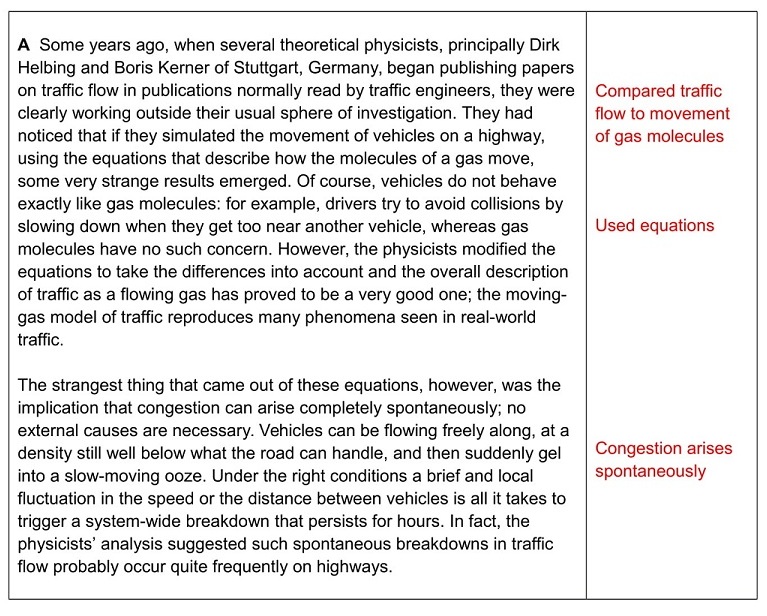
4) Read the headings
Now go to the list of headings. Read through them and try to match your notes on the first section to one of the headings.
Make sure that you read them all carefully and don’t just select the first one that seems to match as there may be two that are very similar in meaning.
Also, look out for key words as clues but also synonyms as these are very likely to be used.
There are two headings that relate to the subject matter of Section A, headings ii and iii.
ii How a maths experiment actually reduced
traffic congestion
iii How a concept from one field of study was applied in another
The mention in Section
A of using ‘equations’ is a match
with ‘maths experiment’ in heading ii
but A is not about reducing traffic
congestion so this can’t be the answer.
Heading iii, on the other hand, is a perfect match. My notes beside the first paragraph are really helpful in making this clear – ‘Compared traffic flow to movement of gas molecules’.
Although the wording is very different, the idea is the same. This is a good example of how paraphrasing is used in this type of question.
Taking the time to make notes when skimming saves having to read the text through again to confirm the information.
You can also see from this first section just how easy it would be to select the wrong heading, that is, heading ii, because there is a closer match of individual words.
maths experiment à equations
Extra tip 1: Similar headings – where you have two headings that could be a possible match and you can’t decide which is the right one, write them out one under the other, as I did above, to help you focus in on the difference between them.
So, the answer is: Section A iii.
Once you've matched a heading, cross through it in pencil to eliminate it from further consideration.
Extra tip 2: If you get stuck on a particular paragraph, move on and come back to it when you’ve matched more headings and crossed them off the list. It will be easier to find the one you’re struggling with when there are fewer headings to choose from.
5) The answer to Section B has been given as an illustration so we can move straight on to Section C.
6) Skim Section C. Again, try to identify the main idea and summarise it in a brief note beside the paragraph.
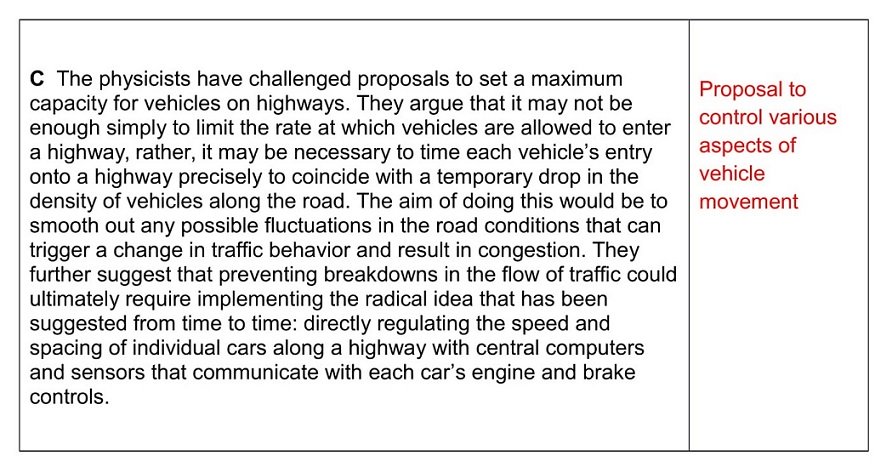
Now go back to the
list of headings. Read through them and try to match your notes on Section C to one of the remaining headings.
There’s one clear match.
viii A proposal to take control away from the driver
This time we actually have a matching key word in the text and heading – ‘proposal’. There’s another one in my summary – ‘control’.
So, the answer is: Section C viii.
7) Now skim Section D
and make your brief notes beside it.
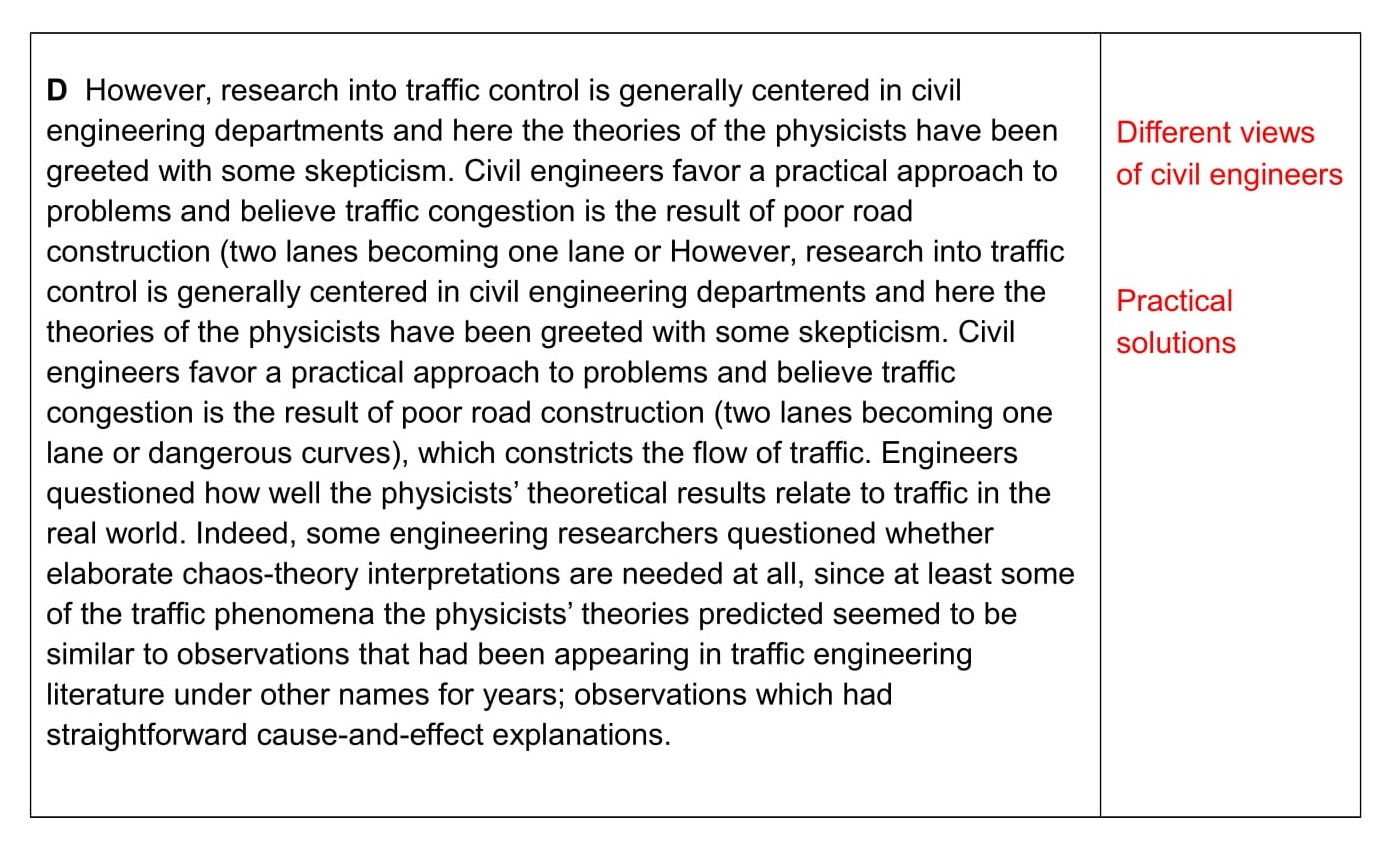
This paragraph is all about the view on traffic
control of civil engineers and how they differ to the theories of the physicists
that we've read about in the previous sections.
8) Read the remaining headings:
iv A lack of investment in driver training
v Areas of doubt and disagreement between experts
vi How different countries have dealt with traffic congestion
vii The impact of driver behaviour on traffic speed
Is there a good match for Section D?
Yes, there is. It’s heading v.
v Areas of doubt and disagreement between experts
Fill in the answer – Section D v – cross through the heading in the list and move swiftly on to the final section of the text.
9) There are two ways to approach the last section. The first is to repeat the same process we’ve used to match headings to the previous sections.
However, since we only have three headings left to match, I’m going to use a different method in the hope of saving a little time.
I’m going to read the headings carefully first then skim the text to see if one of them is a clear match. If not, I should at least be able to quickly narrow the answer down to two out of the three if two are similar in meaning.
Here are the remaining headings and Section E.
iv A lack of investment in driver training
vi How different countries have dealt with traffic congestion
vii The impact of driver behaviour on traffic speed

There’s no mention of ‘investment’
or ‘driver training’ so it can’t be iv.
There’s no mention of ‘different countries’ so it can’t be vi.
That only leaves:
vii - The impact of driver behaviour on traffic speed.
To be sure that you haven’t missed anything, you could quickly scan the paragraph for key words related to ‘driver behaviour’ although you probably don’t need to.
If you do scan, the words ‘driver psychology’ and ‘aggressive drivers’ will confirm that this section is indeed about ‘the impact of driver behaviour’. I’ve highlighted them in the text.
So, the final answer is: Section E vii.
We’ve now completed the first of our IELTS Reading samples.
IELTS Reading
Samples – 2. Diagram Labelling
Here are a few key things that you need to know about this type of question before we start work on the text.
a) Here’s what you have to do:
- You will be given a diagram, a plan or a flowchart.
- You are required to label specific parts or fill in gaps with words from the text or a word list.
b) If you are required to select words from the text for the answers, you'll be told how many words you’re allowed to use for each label. For example, ONE WORD or NO MORE THAN TWO WORDS.
If you use the wrong number of words, your answer will be marked incorrect even if the information you give is correct.
c) Diagram labelling questions are not as hard as they may at first seem. Don’t panic if the diagram looks complicated. It won’t be. A diagram is just another way of presenting information – a combination of language and a drawing.
You need no prior knowledge of the subject in order to complete it. Remember, this is a test of your reading skills, nothing else.
There are lots more tips and information on the main Diagram Labelling page.
So, here’s the diagram (a flowchart in this case) and text of the second of our IELTS reading samples. If you want to use it as a practice test, have a go at answering it yourself before reading my instructions.
Please note that this is just a part of the full text. In the real exam, you would be given the whole text with two or three types of questions attached to it.
Again, I’ve added a PDF of the questions and text that you can download to make it easier to work on. The answers are at the bottom of this page.
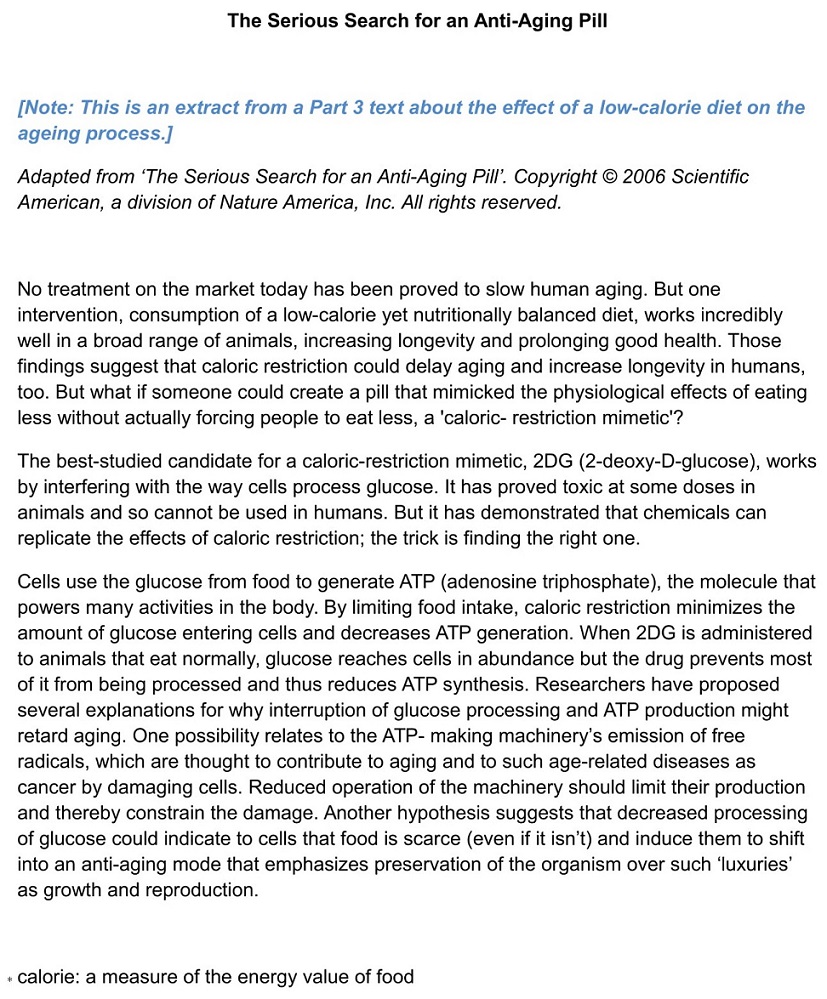
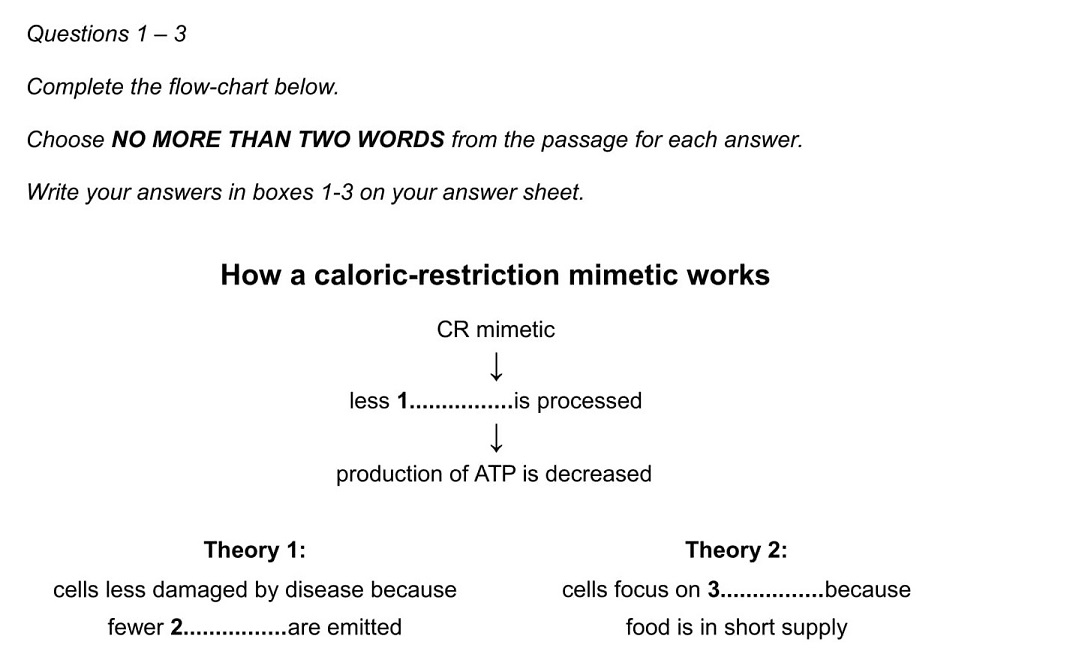
Source of IELTS Reading samples: Official IELTS Website.
Download PDF of IELTS Reading sample.
1) Start by carefully reading the instructions to be sure that you know what you have to do.
This particular question contains a flowchart. You have to find the missing words in the text and must write NO MORE THAN TWO WORDS for each answer.
2) Briefly look at the flowchart and try to get a general understanding of what it’s showing. Headings are especially useful for giving clues.
Don’t panic if there’s a key word that you don’t understand. For example, even as a native English speaker, I don’t know what ‘mimetic’ means. One of these scenarios will apply:
a) The word will appear in a glossary beneath the text.
b) It may be explained in the text or be easy to work out from context.
c) You don’t need to understand it to complete the question.
In this case, it’s meaning is made clear in the text.
There is a glossary, however, and this gives the meaning of ‘calorie’, the most important key word for you to understand.
3) So, let’s think about
what we can learn from looking at the flowchart.
- It’s about a process – restricting calories.
- There are two different theories about how it works.
What do you need to find out from the text?
a) The key thing or idea on which the process is based (Answer 1).
b) The key idea in each theory (Answers 2 & 3).
Don’t spend long on this but if you can get this general understanding of the diagram, it will give you a better idea as to what sort of information you're looking for in the text.
4) You’re now ready to scan the text for key words. ‘Mimetic’ seems the obvious one to start with.

It appears twice. Now read this section of text in detail to understand what is being said.
The first sentence tells us that ‘mimetic’ means to mimic or imitate something. The second sentence reveals that the key to the study is the way ‘glucose’ is processed by the body.
Go back to the flowchart and see if ‘glucose’ would fit as answer 1.
I was about 80% sure that it was correct when I picked it out. To be certain, I scanned on through the text for the word ‘glucose’ to find more information.
I quickly found it several times in the next few sentences which I skim read. This confirmed that I had the right answer.
Answer 1: glucose
5) Now look a Theory 1 and select a key word to scan for.
‘Disease’ is the best choice as it’s the subject of the phrase you’re given.

Here’s the section of text it appears in. Read it in detail to
see if it’s the location of the answer. There’s lots of information to show
that this it is but, as with all reading texts, you need to be looking out for
synonyms and paraphrasing.
For example, the words ’explanations’ and ‘possibility’ in the phrases I’ve underlined, refer to the two different theories in the flowchart. ‘One possibility’ tells us that this sentence is about the first theory.

Look at the flowchart to check what it is you want to know, then read this sentence again. You need to find out what is being emitted.
Answer 2: free radicals
6) There are no words that stand out as obvious key words for Theory 2, so I decide to scan the remaining text for words or a phrase that indicates that another viewpoint or theory is being given.

I quickly spot ‘another hypothesis’, ‘hypothesis’ being a
synonym of ‘theory’. The answer should be here.
Check the flowchart to see what information you need before reading the text in detail.

Again, there is use
of synonyms and paraphrasing, e.g.
Flowchart Text
short supply à scarce
focus on à emphasizes
The answer is well hidden in them but is 'preservation'.
Answer 3: preservation
If you are really struggling to find the answer to a specific question, don’t waste too much time on it. Make a guess and move on. There will be easier questions coming up which you can gain quick marks for. You can always come back to it at the end if there’s time.
I hope you've found the instructions to these IELTS reading samples helpful. Use what you’ve learnt as you practice answering similar questions.
Don’t forget that there are lots more tips for answering these types of questions in the IELTS reading samples on these pages: Matching Heading & Diagram Labelling
Answers
Diagram Labelling
1 Section A iii
2 Section C viii
3 Section D v
4 Section E vii
Answers
Matching Headings
1 glucose
2 free radicals
3 preservation
Like this page?
Find More IELTS Reading Samples
on These Pages
Step-by-step strategies for answering the 12 different types of IELTS Reading questions with examples and practice tests.
You'll Also Find IELTS Reading Samples Here:
IELTS Reading Sample – True, False, Not Given sample test
IELTS Reading Practice Test – Matching Headings and a Diagram Labelling sample tests
IELTS Reading Exercise – Yes, No, Not Given sample test
More Reading Test Practice – Matching Information sample test
IELTS Reading Tests – Two strategies for answering Name Matching questions
IELTS Reading Paper – Multiple Choice sample test
Reading Tests For IELTS – Summary Completion test
